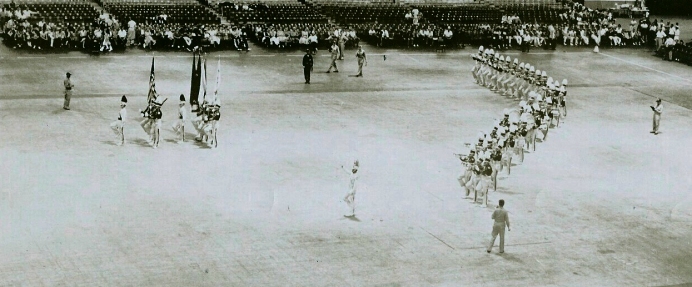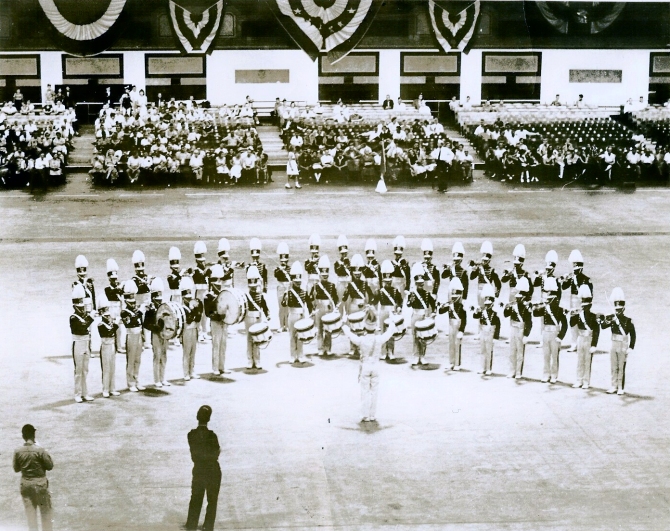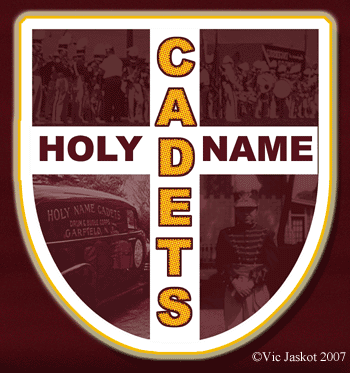| | Cadet History, 1957
by John DeOld, 1956-59
Prologue. When the bus pulled up in front of Holy Name Church, “Chief” (Director, William Kemmerer, Sr.) stood up and said he wanted to say something before we got off. It was 1956 and we had just competed in our last contest of the year. It was a disappointing year; we won no major contests and were unable to beat Blessed Sacrament or St. Vincents. With emotion he said he knew we had a poor year and many of us were talking about leaving. He asked us to stick it out for one more year and work to have a better season. We did stay and start working, and to me that speech on the bus at the end of the 1956 season, was the real start of the 1957 season.
| |
| | I came to Holy Name with Charlie DeBlieck in early 1956 from a small local parade corps. We both played soprano horns, so naturally we were given those great sounding big-belled brass French horns. We lost a number of members following the 1956 season through aging out and started the 1957 season with only 21 horns, six fewer than most other corps. We also had two snare drummers, one less than average. We struggled through the first few months of the season, once again not beating Blessed Sacrament or St. Vincents. We also lost once to Audubon, the well-known New Jersey all-girl corps. Talented as they were, that hurt.
| |
| | New members gradually showed up, and by mid-summer we had 27 horns, and to round it all out a snare drummer from St. Joes showed up. Sometime in August we had our first competition with a full corps. We had a good show and began to sound pretty damn good.
| |
| | There were three major contests in a row in September; The American Legion State Championship in Clifton, followed by the Dream Contest in Jersey City, and finally the American Legion National Championship in Atlantic City. I thought we would beat Blessed Sacrament but not St. Vincents in the State (St. Vincents won almost every contest that year). Then, since St. Vincents sponsored the Dream and they couldn’t compete, we would beat Blessed Sacrament again, have our first major win of the year, and go to Atlantic City with a very good chance of winning.
| |
| | We put on a very good show in the State Contest finishing second to St. Vincents, and we beat Blessed Sacrament for the first time in almost two years. We felt pretty confident standing on the starting line at the Dream Contest. Then an assistant drill instructor had us move eight steps to the right to give the appearance to the crowd of being a larger corps. So, the first time our drill took us close to the sideline, we either went out of bounds or jammed up squads by stopping too soon. The penalty and the loss of marching points blew our chance of winning.
| |
| | We went to Atlantic City with Charlie Nabor, a former Marine, as our temporary drill instructor and Al DeRosa, our horn instructor. They set out to work us all day and into the night. They did just that. The Chief picked the coveted last position in the preliminary contest draw (all contests in that era had a drawing for position immediately preceding the contest).
| |
| | We put on a good show and later found out we had won. That started some celebrations, but most importantly the feeling that we were going to do something great in the finals. We were now the corps to beat. The deep and strong feeling that we had a very good shot at winning that evening began to build.
| |
| | As was our custom as a Catholic corps (most corps from New Jersey at that time were church affiliated), we said the Rosary sitting around the Thunderbird Motel pool. The bus ride from our motel to Convention Hall was the greatest display of corps spirit I ever experienced, before or since. The singing, the confidence oozing from all of us, the sense that we were going to do it, all came together during that short ride.
| |
| | When the bus pulled up to Convention Hall our Drum Major, Tony Bartello spoke to us. Strangely he was standing in the bus where Chief had been standing a year prior when he asked us to stay for one more year. Bart said a lot of people back home are praying for us and one man in particular. Bart simply said let’s go and do the job. I knew his Dad was in the hospital in very serious condition, but that moment seemed to me to tie the beginning of the season which started with Chief’s talk at the end of 1956, to the culmination which awaited us in Atlantic City Convention Hall.
| |
| | We were on next to last, followed by Audubon. On the line I was nervous, but like everyone else I felt confident that we could and would put on a great show. While our drummers were tightening their rope drums a man came up and told them how to do it properly. He was somewhat impolitely asked to leave us alone. Later we learned he was the CEO of Slingerland, the company that made the drums played by the Cadets.
| |
| | The crowd reaction was amazing, starting with our traditional fan cheer “give it the old pepper”. We began immediately with an unusually fast cadence, and kept it fast number by number. There was escalating cheering through the entire show, especially when we hit the metal grating at the end of the color presentation. During that era whenever we marked time our knees came up waist-high, and our feet hit the ground with more than a little force. The cheering continued to grow louder and louder during “The Thunderer,” and our classic prance step got the audience roaring “higher, higher, higher” (referring to the height of our knees).
| |
| | 
The Cadets' famous prance step, during the competition in Atlantic City's Convention Hall. Note: the bulk of the audience was seated up on the second-tier balcony. Photo submitted by Ken Shedosky | |
| | The cheers and the chants grew louder and louder, culminating with a huge roar when we reached the concert presentation (a required element in all drum corps programs at the time). Don Angelica's solo in the concert never sounded sweeter, and when we finished “And the Angels Sing” Convention Hall seemed to explode. We could barely hear ourselves above the roar of the crowd as we continued through the end, and crossed the finish line, with some gasps from the crowd when a number of guys immediately collapsed on the floor as we finished our final fanfare.
| |
| | 
In concert formation on the floor at Convention Hall, as "The Angels Prepare To Sing."
Note the one-handed hold on the bugles. Photo submitted by Ken Shedosky | |
| | Heading towards the finish line I became worried that because of the roar coming from the crowd I wouldn’t hear the 13-minute gun sound. Our fast cadence shaved seconds off of our time on the floor. I was in the last squad closest to where the timer was standing, and I was ready to stay on the field if the gun didn’t go off. It finally did, with about eight steps to spare. Note: Judging began with a gun-shot off-the-line, and finished with a gun-shot at the end of thirteen minutes, when judging would stop).
| |
| | We were asked to host the retreat and awards ceremony, a very elaborate military ceremony based on affiliation with The American Legion. Fifty years later I can still feel the nervous anticipation as each corps’ score and name was announced. Finally there were only two left, and when the announcer said, in second place, from American Legion Post #---- “The Audubon All-Girls”; all the feelings I had welled up inside me froze my body in place. I couldn't move. We were the first corps to march off the floor, per the instructions of the contest director, but I was emotionally and physically drained, and could hardly focus on what was happening.
| |
| | We left Convention Hall in single file; erect, proud, eyes straight ahead. We were Cadets, and after a four year drought, we were National Champions again. As we marched through the massed members of the corps we had competed against, it was like watching the ocean part to permit us to pass. Some just stared in open admiration. Others looked like they were in shock. Audubon was devastated. It was a result that they could not accept, then, or years later. We were also the object of many insults, items thrown at us, members of some corps we had beaten spitting on our Drum Major, but we barely noticed.
| |
| | Epilogue. We were awarded a small, red, military-style guide-on pennant by The American Legion, which read "National Champions." At the mid-winter indoor contest in Newark Armory the following winter, when we were on the line our guide-on bearer marched out with the pennant to signify that the field now belonged to the National Champions. We were penalized for having a flag precede the American Flag and lost the contest as a result.
| |
| | Today, when I think about those years I still feel blessed to have been part of the magical Holy Name Cadets of 1957. Young kids from New Jersey who won that championship and worked through the difficult transition to the Garfield Cadets, after our name and our identity were unceremoniously snatched away from us by a man wearing black with a black heart. In a way I don’t see any problem, legally or theologically, to the Cadets from wherever to change their name back to Holy Name. I would truly like that. I realize of course that it will never happen, and that we still are Holy Name in spirit if not in actual name, but still...I can wish.
For Holy Name shall always be...
| |
| | Editor's note: In 1957 John was our french horn sergeant, along with Dave Shaw our baritone sergeant, Don Angelica our soprano sergeant, Bob Peterson our drum sergeant, Tony Bartello our Drum Major, Tony Giardino our color guard captain, and Rich Konyak our color guard sergeant.
Our instructors were Al DeRosa on horns, Jim Costello on marching, and Bill Westdyk on drums.
Our Director was William Kemmerer, Sr. (The Chief)
The corps moderator was Rev. Roch Coogan
Quartermasters: Joseph Colasso, Joseph Adamo, Thomas Sands, Constance Kardash, and Lillian Fecko.
Other members of the magic corps of 1957:
Color Guard:
Frank Arthur, Paul Arthur, Tommy Sands, Bobby Sands, Ken Shedosky, Rich Weber, John Tambi, and Bob Mohowski
Buglers:
Ray Pych, John Bognatz, Bob Takacs, Ernie Filippelli, Walter Serafin, Ray Carullo, Charlie DeBlieck, Butch DeMaria, Vic Jaskot, George Petrencak, Roger Pratchler, Bill Kardash, Chick DeVito, Tom Adamo, Al Fulvi, George King, Ted Puzio, Rich Jezcerak, Paul Oliveri, John Gangale, John Ganguzza, Bill Tibuto, Bob Arthur, Henry Mura, Dennis Mura, Walter Furca, Arthur Santucci, Fabe Izsa, Michael Porisch, John Avella.
Drummers:
John Fecko, Matty Malkiewicz, Bob Hickey, Walt Bienskie, Larry Garcia, Fred Yarosz, Chuck Roedma, Don Koch, Lou Bonnano, Rudy Jezcerak, Bob Stemmer.
| |
| | Oh Holy Name, my Holy Name
thy name shall be, eternally.
Thy name shall spread,
throughout the land,
and keep it safe,
forevermore.
When on the trail,
or on the march,
you'll know that here
is Holy Name.
March straight and true,
to victory,
for Holy Name
shall always be...
|  | |
| | And so the torch is passed...
 | |
|
